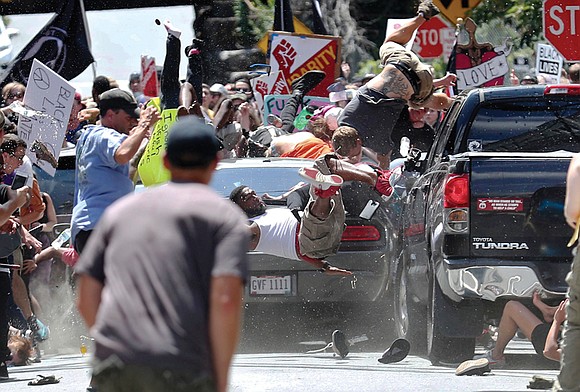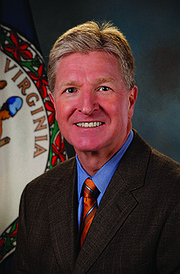Task force: Charlottesville officials failed to act on intelligence that rally would be violent
12/8/2017, 6:13 a.m.

By Saraya Wintersmith
Virginia Public Safety and Homeland Security Secretary Brian J. Moran said last week that state officials had intelligence indicating that the rally of neo-Nazis and white supremacists in Charlottesville would become violent, and shared that information with local officials in advance of the Aug. 12 event.
But Charlottesville officials failed to heed recommendations made by state authorities that may have stemmed the violence and bloodshed that resulted in the death of one person and injuries to dozens more.
Mr. Moran’s comments were made Nov. 30 during a panel on free speech and public safety sponsored by the Virginia Press Association.
His comments were echoed in a 106-page report on the Charlottesville rally that was issued Tuesday by a gubernatorial task force that Mr. Moran headed.
According to the report, Virginia State Police began gathering information about the rally after Jason Kessler, a white nationalist and alt-right organizer, submitted a permit application with the City of Charlottesville in May for the “Unite the Right” rally.
The rally, which authorities said drew hundreds of white supremacists from 35 states, was to protest Charlottesville’s plans to remove the statues of Confederates Robert E. Lee and Stonewall Jackson from city-owned parks.
State Police “identified the potential for violence,” according to the report, and communicated it to the Charlottesville leadership and Mr. Moran “in order to enhance public safety preparations.”
However, the report goes on to describe mounting concern by top state officials over the city’s failure to take precautionary actions. Eventually, Gov. Terry McAuliffe conveyed specific recommendations to Charlottesville’s leadership. Those recommendations, according to the report, included banning guns and other weapons, limiting the permitted protest hours, escorting protesters by bus to the site and strongly communicating a no-tolerance policy for violence or property damage.
“After Gov. McAuliffe communicated these concerns and recommendations with the mayor of Charlottesville on Aug. 2, (State Police) also briefed the mayor, city manager and members of the City Council that same day. The recommendations contained in the memorandum and communicated to the city were not followed,” Mr. Moran stated in the report.
“When asked why the governor’s recommendations were not followed during our final task force meeting, the International Association of Chiefs of Police indicated that interviews suggested that advice from the city’s legal counsel played a role.”
The report by the Governor’s Task Force on Public Safety Preparedness and Response to Civil Unrest is the latest analysis to suggest that state and local officials did not collaborate as closely as they could have to prevent violence at the Unite the Right rally.
POLITICO reported shortly after the event that the U.S. Department of Homeland Security issued a warning to law enforcement authorities suggesting the Aug. 12 rally would be “among the most violent to date” between white supremacists and anarchists.
A separate, recently published review led by former federal prosecutor Timothy Heaphy concluded that local officials were ill-prepared and made multiple mistakes leading up to the rally, including attempting to move the gathering to a larger public park.
During last week’s panel, Claire Guthrie Gastanaga, executive director of the Virginia ACLU that represented Mr. Kessler, the rally organizer, during a court hearing about the move, recounted the arguments in the hearing held the day before the rally that led U.S. District Court Judge Glen E. Conrad to allow it to take place in the city park where the statue of Confederate Robert E. Lee is located.
“The city came into that hearing … and they made no showing about safety,” said Ms. Gastanaga.
Instead of presenting information that violence was expected, attorneys for the city cited crowd size as a reason for suddenly wanting to move the rally, she said.
“There was actionable intelligence that someone could have put in front of a judge, but no one did,” she said.
“There’s no right to violent assembly,” she said. “There’s right to peaceful assembly.”
While her organization has come under fire for its role in helping the rally go forward, Ms. Gastanaga maintained the ACLU is committed to ensuring that government acts in accordance with the U.S. Constitution and does not infringe upon free speech unlawfully.
Multiple media accounts detailed the violent skirmishes in Charlottesville as neo-Nazis and white supremacists clashed with counterprotesters. Dozens of people were hurt and 32-year-old Heather Heyer was killed when a white supremacist drove his car into a crowd of counterprotesters.
Recalling the day’s events, Mr. Moran said it was “surreal” seeing several dozen armored protesters equipping themselves with long guns as passersby walked a dog and pushed a baby stroller.
The task force report contains dozens of recommendations, including the need for a “more robust” permitting process for future rallies and restrictions on weapons and on how many people are allowed and for how long.
Mr. Moran insisted the report was not meant to “second guess decision makers or assign blame,” but to look forward with the goal of preventing such violence in the future.
In the report, he went on to commend Richmond’s handling of a rally on Sept. 16 at the Lee statue on Monument Avenue that was organized without a permit by a neo-Confederate group from Tennessee.
In that instance, Richmond Police spent more than $500,000 for personnel and equipment and operating expenses to handle the rally called by CSA II: The New Confederate States of America to protest the possible removal of the state-owned Lee statue.
The event saw less than a dozen protesters outnumbered by hundreds of counterprotesters. Police kept the two groups separate throughout the day.
Following the panel, Mr. Moran declined to say whether he believes the removal of Confederate statues would quell future rallies and their potential for violence. He said a bill likely will be submitted in the upcoming General Assembly session that would allow localities to ban firearms from certain permitted events in the interest of maintaining public safety.








